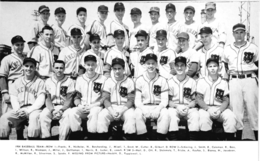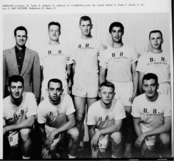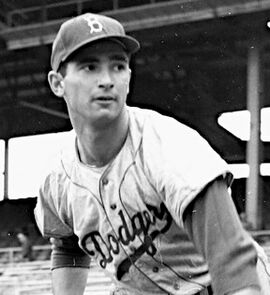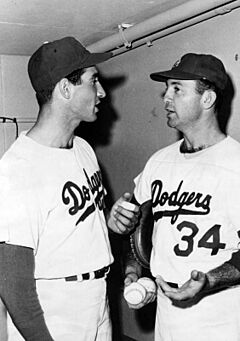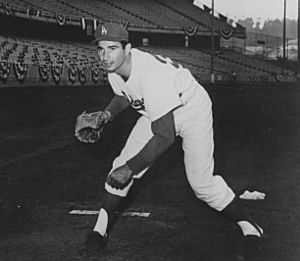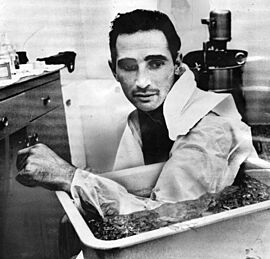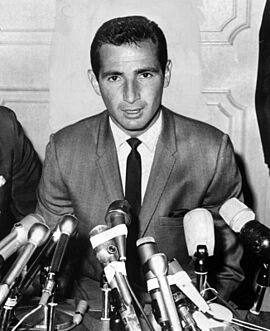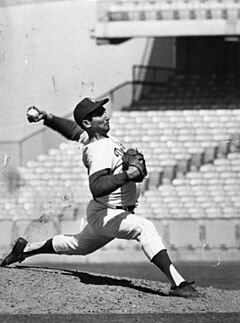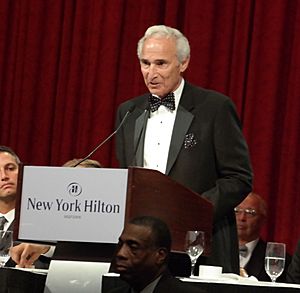Sandy Koufax facts for kids
Quick facts for kids Sandy Koufax |
|||
|---|---|---|---|
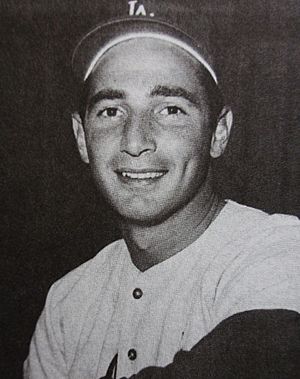
Publicity still of Koufax, c. 1965
|
|||
| Pitcher | |||
| Born: December 30, 1935 Brooklyn, New York, U.S. |
|||
|
|||
| debut | |||
| June 24, 1955, for the Brooklyn Dodgers | |||
| Last appearance | |||
| October 2, 1966, for the Los Angeles Dodgers | |||
| MLB statistics | |||
| Win–loss record | 165–87 | ||
| Earned run average | 2.76 | ||
| Strikeouts | 2,396 | ||
| Teams | |||
|
|||
| Career highlights and awards | |||
|
|||
| Induction | 1972 | ||
| Vote | 86.9% (first ballot) | ||
Sanford Koufax (/ˈkoʊfæks/; born December 30, 1935), often called "the Left Arm of God", is a famous American former baseball pitcher. He played 12 seasons in Major League Baseball (MLB) for the Brooklyn and Los Angeles Dodgers from 1955 to 1966. Many people think Koufax is one of the best pitchers ever.
He was the first pitcher to win the Cy Young Award three times, and he won it unanimously each time. In 1963, he was also named the National League Most Valuable Player. Koufax retired at age 30 because of pain in his pitching elbow. He was elected to the Baseball Hall of Fame in 1972, becoming the youngest player ever chosen at age 36.
Koufax was born in Brooklyn, New York. When he was young, he mostly played basketball and only pitched a few baseball games. He signed with the Brooklyn Dodgers when he was 19. Because of a special rule, Koufax never played in the minor leagues. This meant he didn't get much pitching experience early on.
For his first six seasons, Koufax didn't play consistently and struggled. He even thought about quitting baseball after the 1960 season. But after making some changes before the 1961 season, Koufax became one of the best pitchers in the major leagues. He was an All-Star in his last six seasons. He led the National League (NL) in earned run average for five years in a row. He also led in strikeouts four times, and in wins and shutouts three times each.
Koufax won the Major League Triple Crown three times. He led the Dodgers to win their league's championship in each of those years. He was the first major league pitcher to throw four no-hitters, including a perfect game in 1965. He was named the World Series MVP twice. He helped the Dodgers win the World Series in 1963 and 1965.
Even though his career was short, his 2,396 career strikeouts were the seventh most in major league history at the time. His 40 shutouts were tied for ninth in modern NL history. Koufax was the first pitcher to average more than nine strikeouts per nine innings pitched. He was also the first to allow fewer than seven hits per nine innings pitched.
Koufax and his teammate Don Drysdale were important in baseball's labor movement. They held out together for a better contract before the 1966 season. Koufax is also seen as one of the greatest Jewish athletes. He famously chose not to play in Game 1 of the 1965 World Series because it was on Yom Kippur, a very important Jewish holiday. This made him a hero in the American Jewish community.
After retiring, Koufax has mostly stayed out of the public eye. He worked as a broadcaster for NBC for six years but didn't enjoy it. In 1979, he became a pitching coach for the Dodgers' minor league teams. He left that role in 1990 but still visits during spring training. From 2013 to 2015, Koufax was a special advisor for the Dodgers.
In 1999, he was named to the Major League Baseball All-Century Team. His number 32 was retired by the Dodgers in 1972. A statue of him was put up outside Dodger Stadium in 2022.
Contents
Early Life and Baseball Start
Koufax was born Sanford Braun on December 30, 1935, in Borough Park, Brooklyn. His parents divorced when he was three. He spent much of his childhood with his grandparents. His mother remarried when he was nine to Irving Koufax, and Sandy took his stepfather's name. The family later moved to Bensonhurst.
As a kid, Koufax was better known for basketball. He was the captain of his high school basketball team. He started playing baseball in a local youth league as a catcher and then first base. A coach named Milt Laurie saw Koufax's strong throwing arm. Laurie encouraged him to try pitching for a local team called the Parkviews.
Koufax went to the University of Cincinnati for basketball. He later joined the college baseball team as a pitcher. He had a good season, winning 3 games and striking out 51 batters in 32 innings.
Major League Tryouts
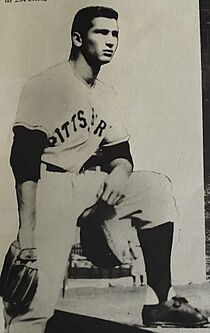
Baseball scouts started to notice Koufax. A scout for the Brooklyn Dodgers, Al Campanis, heard about him. Campanis set up a tryout for Koufax at Ebbets Field. Dodgers manager Walter Alston and scouting director Fresco Thompson watched him pitch. Campanis later said Koufax's fastball was amazing.
Koufax's father helped him negotiate a contract with the Dodgers. They agreed on $20,000, which included a $14,000 signing bonus. This bonus was important because it meant Koufax would go straight to the major leagues. He officially signed with his hometown team on December 14, 1954.
Professional Baseball Career
When Koufax signed, there was a rule called the bonus rule. It said that if a team paid a player a bonus over $4,000, they had to keep him on their main roster for two seasons. This meant Koufax never played in the minor leagues.
In his first spring training, Koufax had a sore arm. He also didn't know much about pitching basics. He had only pitched a few games in college and local leagues. This lack of experience meant it took him longer to become a great pitcher.
Early Years (1955–1960)
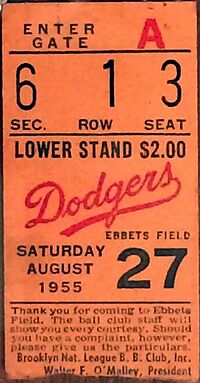
Koufax made his major league debut on June 24, 1955. He pitched two scoreless innings. On August 27, he earned his first major league win. He threw a two-hit, 7–0 complete game shutout against the Cincinnati Redlegs. He struck out 14 batters in that game.
In his first year, Koufax had a record of 2–2 with a 3.02 earned run average. The Dodgers won the 1955 World Series, but Koufax didn't play in it.
The 1956 season was similar. Koufax had a very fast fastball but struggled to control it. He pitched only a few innings. Teammates like Jackie Robinson and Roy Campanella thought manager Walter Alston should let Koufax pitch more.
In 1957, Koufax played winter baseball in Puerto Rico to improve. On May 15, he struck out 13 batters in his first complete game in almost two years. He became a regular starter for a short time.
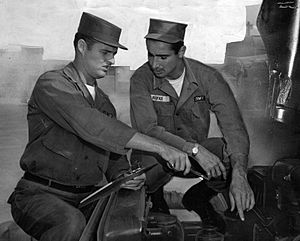
Koufax and teammate Don Drysdale served in the United States Army Reserve from 1957 to 1959.
In 1959, Koufax set a record for a night game with 16 strikeouts. On August 31, he tied the Major League record of 18 strikeouts in a single game. The Dodgers won the 1959 World Series that year. Koufax pitched in Game 1 and started Game 5.
By early 1960, Koufax was frustrated. He asked the Dodgers to trade him because he wasn't playing enough. He even thought about quitting baseball after the season. He had a record of 36–40 in his first six seasons.
Becoming a Star (1961–1964)
Koufax decided to give baseball another try. He wanted to see how good he could really be. He worked on his pitching style during the offseason. A Dodgers scout helped him fix a small problem in his windup. Catcher Norm Sherry also gave him advice to stay calm and not throw too hard when he was in trouble.
1961 Season: A Breakthrough
All the hard work paid off in 1961. Koufax had a great season, with an 18–13 record. He led the major leagues with 269 strikeouts, breaking a 58-year-old record. This was the first time he started at least 30 games and pitched over 200 innings.
1962 Season: Moving to Dodger Stadium
In 1962, the Dodgers moved to Dodger Stadium. This new park was good for pitchers. Koufax immediately benefited. He led the NL in ERA and the majors in hits per nine innings and strikeouts per nine innings.
On June 30, Koufax threw his first career no-hitter against the New York Mets. He also threw an "immaculate inning" in the first inning, striking out three batters on nine pitches.
Later that season, Koufax had a hand injury. He had a crushed artery in his palm. He missed time but returned in September. The Dodgers were in a close race with the Giants. Koufax pitched in the playoff game, but he was not fully recovered. The Dodgers lost the pennant.
1963 Season: Triple Crown Winner
In 1963, baseball changed the strike zone to help pitchers. Koufax improved his control even more. On April 19, he threw his second "immaculate inning."
Koufax threw his second career no-hitter on May 11 against the San Francisco Giants. He almost pitched a perfect game, but walked a batter in the eighth inning.
In 1963, Koufax won his first of three pitching Triple Crowns. He led the majors in wins (25), strikeouts (306), and earned run average (1.88). He also threw 11 shutouts, a record for a left-handed pitcher.

Koufax won the National League Most Valuable Player Award. He was also the first pitcher to win the Cy Young Award unanimously. The Dodgers faced the New York Yankees in the 1963 World Series. Koufax struck out 15 batters in Game 1, a World Series record. The Dodgers swept the Yankees in four games. Koufax was named the World Series MVP.
Playing Through Pain (1965–1966)
After the 1964 season, Koufax was diagnosed with arthritis in his pitching elbow. His doctor warned him that continuing to pitch could cause permanent damage. Koufax decided to keep playing but followed a strict routine. He would put a special ointment on his arm and soak it in ice after every game. He also took medication for the pain.
1965 Season: More Records and a Perfect Game
Despite the pain, Koufax had an amazing 1965 season. He led the major leagues with 335.2 innings pitched and 27 complete games. He won his second pitching Triple Crown, leading in wins (26), ERA (2.04), and strikeouts (382). His 382 strikeouts broke a modern record. He won his second unanimous Cy Young Award.
On September 9, 1965, Koufax threw a perfect game against the Chicago Cubs. This was his fourth no-hitter, setting a new major league record at the time. He struck out 14 batters in the 1–0 win.
World Series and Yom Kippur Decision
The Dodgers won the NL pennant in 1965. Koufax made national news when he chose not to start Game 1 of the 1965 World Series. This was because the game fell on Yom Kippur, a very important Jewish holiday. His teammate Don Drysdale pitched instead.
Koufax pitched in Game 2 and Game 5. In Game 5, he threw a four-hit shutout. The series went to Game 7. Koufax started on only two days' rest and pitched a three-hit shutout to win the World Series for the Dodgers. He won the World Series MVP Award for the second time.
The Holdout and Final Season
Before the 1966 season, Koufax and Drysdale decided to negotiate their contracts together. This was very unusual at the time. They asked for $1 million, split between them over three years. The Dodgers refused at first.

The players held out and did not report to spring training. Eventually, a meeting was arranged. Koufax signed for $125,000 and Drysdale for $110,000. This made Koufax the highest-paid player in baseball for 1966. This holdout was a big step for players' rights in baseball.
1966 Season: A Final Masterpiece

In April 1966, Koufax's doctor told him it was time to retire. Koufax had already decided that 1966 would be his last season. He pitched every fourth day, even though his arm hurt and sometimes went numb.
He had an incredible final season, with a 27–9 record, 317 strikeouts, and a 1.73 earned run average. He won his third pitching Triple Crown. He also won his third unanimous Cy Young Award.
In the final game of the regular season, Koufax pitched a complete game victory to win the pennant for the Dodgers. He injured his back during the game but kept pitching.
The Dodgers faced the Baltimore Orioles in the 1966 World Series. Koufax started Game 2. He pitched well, but three errors by his centerfielder led to unearned runs. The Dodgers' offense struggled, and they were swept in four games.
Retirement
On November 18, 1966, Koufax announced his retirement at a press conference. He was only 30 years old. He explained that he wanted to live a full life after baseball with the use of his arm. He didn't want to risk permanent injury.
His retirement shocked many, especially his teammates. Koufax later said he never regretted his decision. His retirement ended an amazing five-year period where he had a record of 111–34 with a 1.95 ERA. He led the Dodgers to three league championships and two World Series titles.
Career Highlights
In his 12-season career, Koufax had a 165–87 record with a 2.76 earned run average. He had 2,396 strikeouts, 137 complete games, and 40 shutouts. He was the first pitcher to average fewer than seven hits allowed per nine innings. He was also the first to strike out more than nine batters per nine innings.
Koufax was the first pitcher to win three Cy Young Awards. This was especially impressive because, at the time, only one award was given for both major leagues. He was also the first pitcher to win the award by a unanimous vote, which he did three times.
He set records for games with many strikeouts. He is considered one of the greatest pitchers in important games like the World Series. His 0.95 ERA and two World Series MVP Awards show how well he pitched. He was selected as an All-Star for six seasons in a row.
| Category | W | L | ERA | G | GS | CG | SHO | SV | IP | H | R | ER | HR | BB | IBB | SO | HBP | ERA+ | FIP | WHIP | H/9 | SO/9 | Ref. |
|---|---|---|---|---|---|---|---|---|---|---|---|---|---|---|---|---|---|---|---|---|---|---|---|
| Total | 165 | 87 | 2.76 | 397 | 314 | 137 | 40 | 9 | 2,324.1 | 1,754 | 806 | 713 | 204 | 817 | 48 | 2,396 | 18 | 131 | 2.69 | 1.106 | 6.8 | 9.3 |
Pitching Style
Koufax was a power pitcher. He threw with a strong, over-the-top arm motion. His power came from his legs and back. His large hands helped him put a lot of spin on his pitches.
Koufax was a fierce competitor on the mound. He wasn't afraid to pitch inside to batters. He mostly used two main pitches. His four-seam fastball seemed to rise as it approached the batter. His overhand curveball dropped sharply, sometimes 12 to 24 inches. Many people think it was the best curveball ever.
He also had a changeup and later used a forkball. In his final seasons, he added a cutter to his pitches.
Life After Baseball
After retiring, Koufax worked as a broadcaster for NBC. He wasn't comfortable talking on camera and left after six years. In 1979, he became a minor league pitching coach for the Dodgers. He helped many young pitchers, including future Hall of Famers.
Koufax later became a special advisor for the Dodgers from 2013 to 2015. He helps the Baseball Assistance Team (B.A.T.), which supports former baseball players. He also serves on the board of the Hole in the Wall Gang Camp, a camp for children with illnesses.
Honors and Recognition
 |
|
| Sandy Koufax's number 32 was retired by the Los Angeles Dodgers in 1972. |
Koufax was elected to the Baseball Hall of Fame in 1972. He was the youngest person ever elected at 36 years old. He was also the second Jewish player to enter the Hall of Fame.
On June 4, 1972, the Dodgers retired Koufax's uniform number 32. A statue of him was unveiled at Dodger Stadium in 2022.
In 1999, The Sporting News ranked Koufax number 26 on its list of "Baseball's 100 Greatest Players." He was also named to the Major League Baseball All-Century Team. In 2015, fans voted Koufax as one of the four greatest living players.
Impact and Legacy
Impact within the Jewish Community
Koufax's importance in the Jewish community is significant. He helped change the idea that Jewish men were not athletic. His decision to sit out Game 1 of the 1965 World Series for Yom Kippur made him an icon for American Jews.
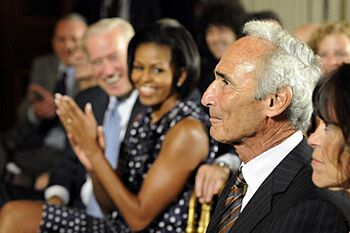
Rabbi Rebecca Alpert explained that his decision mattered a lot to a generation of Jewish men. He was a role model and a hero. Rabbi Bruce Lustig said Koufax helped change how Jews were seen.
Koufax was inducted into the International Jewish Sports Hall of Fame in 1979. In 2010, he was honored at the White House for Jewish American Heritage Month. President Barack Obama noted the loud cheer Koufax received. He was also a main subject in the film Jews and Baseball: An American Love Story.
Relationship with Other Minorities
Koufax was seen as a friend to minority players. Teammate Maury Wills recalled that Koufax would sort through racist and antisemitic mail with him. Pitcher Joe Black said Koufax would always sit with the Black players in restaurants. He treated everyone with respect.
Koufax identified with minorities because he was Jewish. He faced antisemitism himself. This helped him understand and connect with other minority players.
Personal Life
Koufax was raised in a secular Jewish home. His decision not to pitch on Jewish holidays was out of respect for his culture. He later became a reader of Jewish and Holocaust literature.
Despite being a big star, Koufax has kept a low profile since retiring. He rarely gives interviews. He was known for being shy and reserved during his career. He didn't like being a celebrity.
Koufax was a smoker during his playing days but refused to endorse tobacco or alcohol. He didn't want to send the wrong message to kids.
In 2009, Koufax was one of the people who lost money in the Bernie Madoff Ponzi scheme. He had invested with Madoff on a friend's recommendation.
In 2012, Koufax shared that he had been diagnosed with cancer in 2010. He said, "Today, I'm a survivor."
He lives in Vero Beach, Florida, and also in Hellertown, Pennsylvania. In his forties and fifties, Koufax became very active. He took up running and participated in marathons. He is also a lifelong golfer and still plays. He enjoys college basketball and attends the NCAA Final Four.
Koufax is also a wine enthusiast and knows a lot about wine.
See also
 In Spanish: Sandy Koufax para niños
In Spanish: Sandy Koufax para niños
- Major League Baseball titles leaders
- Major League Baseball Triple Crown
- List of Los Angeles Dodgers team records
- List of Jewish Major League Baseball players
- List of Major League Baseball annual ERA leaders
- List of Major League Baseball annual strikeout leaders
- List of Major League Baseball annual wins leaders
- List of Major League Baseball annual shutout leaders
- List of Major League Baseball career strikeout leaders
- List of Major League Baseball career WHIP leaders
- List of Major League Baseball career FIP leaders
- List of Major League Baseball career ERA leaders
- List of Major League Baseball career shutout leaders
- List of Major League Baseball individual streaks
- List of Major League Baseball no-hitters
- List of Major League Baseball perfect games
- List of Major League Baseball single-game strikeout leaders
- List of Major League Baseball pitchers who have thrown an immaculate inning
- List of Major League Baseball players who spent their entire career with one franchise
- List of baseball players who went directly to Major League Baseball
- List of World Series starting pitchers


